According to the latest OECD data, published today, whilst we are lagging behind other developed OECD countries in fixed broadband, we rank third in the world for wireless broadband behind Finland and Japan. Some Australians have more than one wireless service and mobile growth is significantly higher than fibre.
Using June 2014 data, Australia ranked 20 out of 34 OECD countries based on the number of fixed broadband connections for 100 inhabitants, behind nations including Switzerland, UK Korea, New Zealand and Japan. Total penetration was around 27 per cent. About 81 per cent of connections were via DSL, 15 per cent and 3 per cent fibre. Our fibre rates are lower than the 17% OECD average.  Mobile broadband penetration has risen to 78.2% in the OECD area, making more than three wireless subscriptions for every four inhabitants, according to data for June 2014 released today.
Mobile broadband penetration has risen to 78.2% in the OECD area, making more than three wireless subscriptions for every four inhabitants, according to data for June 2014 released today.
Mobile broadband subscriptions in the 34-country area were up 11.9% from a year earlier to a total of 983 million, driven by growing use of smartphones and tablets.
Seven countries (Finland, Japan, Australia, Sweden, Denmark, Korea and the United States as ranked in descending order of mobile broadband subscriptions) lie above the 100% penetration threshold.
Fixed broadband subscriptions in the OECD area reached 344.6 million as of June 2014, up from 332 million in June 2013 and making an average penetration of 27.4%. Switzerland, the Netherlands and Denmark remained at the top of the table with 47.3%, 40.8% and 40.6% respectively.
DSL remains the prevalent technology, making up 51.5% of fixed broadband subscriptions, but it continues to be gradually replaced by fibre, now at 17% of subscriptions. Cable (31.4%) accounted for most of the remaining subscriptions.
Annual growth of above 100% in fibre take-up was achieved in OECD economies with low to average ratio of fibre to total fixed broadband levels such as New Zealand, Luxembourg, Chile and Spain. Japan and Korea remain the OECD leaders, with fibre making up 71.5% and 66.3% of fixed broadband connections.
Full details are available from the OECD Broadband portal.

